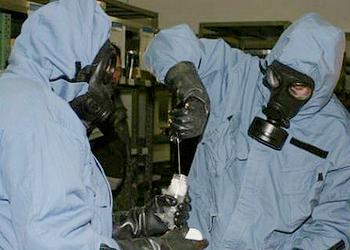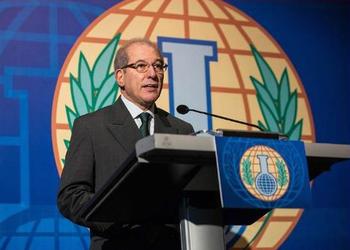
THE HAGUE, The Netherlands, October 31, 2013 (ENS) – Syria’s chemical weapons facilities are now “inoperable,” the Joint Mission of the Organisation for the Prohibition of Chemical Weapons and the United Nations confirmed today.
All equipment used in the production of chemical agents has been crushed or filled with concrete to render it inoperable in accord with a UN Security Council resolution last month.
“The Joint Mission is now satisfied that it has verified – and seen destroyed – all of Syria’s declared critical production and mixing/filling equipment,” the joint OPCW-UN team said in a statement.
“No further inspection activities are currently planned,” the team said.
The Joint Mission confirmed that Syria has met the deadline set by the agency to “complete as soon as possible and in any case not later than 1 November 2013, the destruction of chemical weapons production and mixing/filling equipment.”
The Joint OPCW-UN Mission has inspected 21 of the 23 sites declared by Syria, and 39 of the 41 facilities located at those sites.
The two remaining sites were not visited due to safety and security concerns. Damascus declared those sites “abandoned,” the agency said, and the chemical weapons program items they contained were moved to other declared sites, which were inspected, the Joint Mission explained.
The Joint Mission is now satisfied that it has verified – and seen destroyed – all of Syria’s declared critical production and mixing/filling equipment.

Given the progress made in the Joint OPCW-UN Mission in meeting the requirements of the first phase of activities, no further inspection activities are currently planned.
Eight of the OPCW inspectors who participated in the process today returned to The Hague, after nearly a month a Damascus.
OPCW Director-General Ahmet Üzümcü thanked them, saying, “On behalf of the OPCW, I thank you and all of our colleagues from the Joint OPCW-UN Mission who remain in Syria for your outstanding service.”
“I salute the fortitude and courage you’ve all demonstrated in fulfilling the most challenging mission ever undertaken by this Organisation,” he said.
The next milestone for the Joint Mission will be November 15, by which time the Nobel Peace Prize-winning chemical weapons watchdog must approve the plan submitted by Damascus detailing the elimination of its entire chemical weapons stockpile.
Syria submitted a formal declaration of its chemical weapons program three days ahead of the October 27 deadline, together with a general plan of destruction, for consideration by the OPCW Executive Council.
On October 14, the Chemical Weapons Convention entered into force for the Syrian Arab Republic, making it the 190th State Party to the treaty.

Protection of human health and preservation of the environment is one of the primary obligations for all States Parties during chemical weapons transportation, sampling, storage as well as during destruction operations of chemical weapons and former production facilities.
Each State Party can determine how to destroy its chemical weapons, with the exception of the prohibited measures of sea dumping, land burial and open-pit burning, which are banned for ecological reasons.
The selected destruction technology should minimize the risk of agent release during storage, transportation and disposal operations, as well as reducing to a minimum the public health and environmental impact from process effluents.
Before being discharged into the environment, recycled, used commercially or as landfill, effluent streams must be analyzed and treated to ensure that any remaining trace contaminants, organic or inorganic, are at acceptable levels, in compliance with national standards for release.
It is the responsibility of each State Party to consider the impact of the destruction process across the entire environmental spectrum – air, water, land – and apply the best environmental option.
The UN Security Council has endorsed Secretary-General Ban Ki-moon’s plan to deploy up to 100 UN and OPCW experts in a multi-phase operation to carry out the Security Council resolution on eliminating Syria’s chemical weapons material and equipment by June 30, 2014.
The Council passed its resolution after Syria agreed to join the Chemical Weapons Convention following a chemical weapons attack in August that killed hundreds of people in a Damascus suburb.
The attack came in a conflict that has already killed over 100,000 people and driven some 6.5 million others from their homes since protesters first sought the ouster of President Bashar al-Assad’s government in March 2011.
Copyright Environment News Service (ENS) 2013. All rights reserved.
